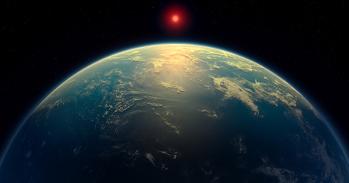
An international team of astronomers has discovered an ancient and dramatic head-on collision between the Milky Way and a smaller object, dubbed ‘the Sausage galaxy’. The cosmic crash was a defining event in the early history of the Milky Way and reshaped the structure of our galaxy, fashioning both the galaxy’s inner bulge and its outer halo, the astronomers report in a series of new papers.
An international team of astronomers has discovered an ancient and dramatic head-on collision between the Milky Way and a smaller object, dubbed ‘the Sausage galaxy’. The cosmic crash was a defining event in the early history of the Milky Way and reshaped the structure of our galaxy, fashioning both the galaxy’s inner bulge and its outer halo, the astronomers report in a series of new papers.
These Sausage stars are what's left of the last major merger of the Milky Way.
Wyn Evans
The astronomers propose that around eight to 10 billion years ago, an unknown dwarf galaxy smashed into our own Milky Way. The dwarf did not survive the impact. It quickly fell apart, and the wreckage is now all around us.
“The collision ripped the dwarf to shreds, leaving its stars moving on very radial orbits, like needles,” said Vasily Belokurov of the University of Cambridge and the Center for Computational Astrophysics at the Flatiron Institute in New York City. “These stars’ paths take them very close to the centre of our galaxy. This is a tell-tale sign that the dwarf galaxy came in on a really eccentric orbit and its fate was sealed.”
The salient features of this extraordinary event are outlined in several new papers, some of which were led by Cambridge graduate student GyuChul Myeong. He and colleagues used data from the European Space Agency's Gaia satellite. This spacecraft has been mapping the stellar content of our galaxy, recording the journeys of stars as they travel through the Milky Way. Thanks to Gaia, astronomers now know the positions and trajectories of our celestial neighbours with unprecedented accuracy.
“The paths of the stars from the galactic merger earned the moniker ‘Gaia Sausage’,” said Wyn Evans of Cambridge’s Institute of Astronomy. “We plotted the velocities of the stars, and the sausage shape just jumped out at us. As the smaller galaxy broke up, its stars were thrown out on very radial orbits. These Sausage stars are what's left of the last major merger of the Milky Way.”
There are ongoing mergers taking place right now, such as between the puny Sagittarius dwarf galaxy and the Milky Way. However, the Sausage galaxy was much more massive. Its total mass in gas, stars and dark matter was more than 10 billion times the mass of our sun. When it crashed into the young Milky Way, it caused a lot of mayhem. The Sausage’s piercing trajectory meant that the Milky Way’s disk was probably puffed up or even fractured following the impact, and the Milky Way had to re-grow a new disk. At the same time, the Sausage debris was scattered all around the inner parts of the Milky Way, creating the ‘bulge’ at the galaxy’s centre and the surrounding ‘stellar halo’.
“Numerical simulations of the galactic smash-up can reproduce these features,” said Denis Erkal of the University of Surrey. In simulations ran by Erkal and colleagues, stars from the Sausage galaxy enter stretched out orbits. The orbits are further elongated by the growing Milky Way disk, which swells and becomes thicker following the collision.
“Evidence of this galactic remodelling is seen in the paths of stars inherited from the dwarf galaxy,” said Alis Deason of Durham University. “The Sausage stars are all turning around at about the same distance from the centre of the Galaxy. These U-turns cause the density in the Milky Way’s stellar halo to drop dramatically where the stars flip directions.” This discovery was especially pleasing for Deason, who predicted this orbital apocentric pile-up almost five years ago.
The new research also identified at least eight large, spherical clumps of stars called globular clusters that were brought into the Milky Way by the Sausage galaxy. Small galaxies do not normally have globular clusters of their own, so the Sausage galaxy was big enough to host its own entourage of clusters.
“While there have been many dwarf satellites falling onto the Milky Way over its life, this was the largest of them all,” said Sergey Koposov of Carnegie-Mellon University, who has been studying the kinematics of the Sausage stars and globular cluster in detail.
The head-on collision of the Sausage galaxy was a defining event in the early history of the Milky Way. It created the thick disk and the inner stellar halo. Even though the merger took place at a very remote epoch, the stars in the Sausage galaxy can be picked out today. Memory of this event persists in the kinematics and chemistry of its stars. Thanks to the Gaia satellite, astronomers have miraculous data with which we can peer back into the very distant past and recreate the pre-history of our galactic home.

The text in this work is licensed under a Creative Commons Attribution 4.0 International License. Images, including our videos, are Copyright ©University of Cambridge and licensors/contributors as identified. All rights reserved. We make our image and video content available in a number of ways – as here, on our main website under its Terms and conditions, and on a range of channels including social media that permit your use and sharing of our content under their respective Terms.




